Brake Caliper Inspection Front
Caution: Refer to Brake Dust Caution in the Preface section.
Caution: Refer to Brake Fluid Irritant Caution in the Preface section.
- Inspect the fluid level in the master cylinder reservoir.
| • | If the brake fluid level is midway between the maximum-fill level and
the minimum allowable level, no brake fluid needs to be removed from the master cylinder
reservoir before proceeding. |
| | Important: DO NOT completely empty the master cylinder
reservoir or remove any brake lines otherwise complete bleeding of the braking system
will be necessary.
|
| | Important: DO NOT reuse the removed fluid.
|
| • | If the brake fluid level is higher than midway between the maximum-fill level
and the minimum allowable level, syphon the brake fluid to the midway point using
a hand vacuum pump before proceeding. |
- Remove wheels. Refer to
Tire and Wheel Removal and Installation
in Tires and Wheels.
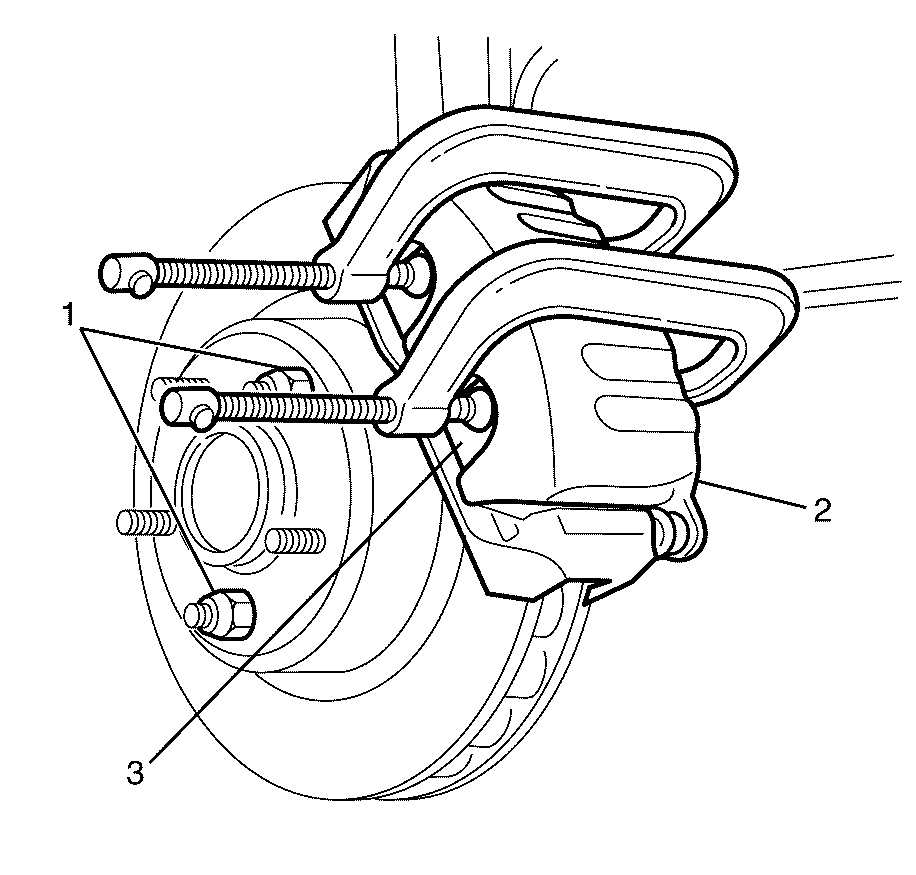
- Install two wheel nuts (1) in reverse
to opposite wheel studs to retain the brake disc to the hub.
Important: Position the ends of the G-clamps against
the rear of the brake caliper (2) and against the outboard brake pad (3).
- Install large G-clamps over the body of the brake caliper (2).
Important: The movement of a brake caliper piston into
a brake caliper bore should be smooth and even. If a brake caliper piston is frozen
or difficult to bottom out, the brake caliper requires overhaul or replacement.
- Inspect for smooth and complete travel of the brake caliper pistons, into the
brake caliper bores.
Tighten the G-clamps until the brake caliper pistons bottom out in the brake
caliper bores.
- Remove the G-clamps from the brake caliper (2).
- Grasp the brake caliper (2) and try to move the brake caliper (2)
up or down.
The brake caliper (2) should have minimal freeplay.
- Grasp the brake caliper (2) and try to move the brake caliper (2)
in and out.
The brake caliper (2) should slide smoothly with minimal
force.
Important: DO NOT disconnect the hydraulic brake flexible
hose from the brake caliper.
- Remove the brake caliper (2). Refer to
Front Brake Caliper Replacement
.
Notice: Support the brake caliper with heavy mechanic wire, or equivalent,
whenever it is separated from its mount and the hydraulic flexible brake hose is still connected. Failure to support the caliper in this manner will cause the flexible brake hose to bear the weight of the caliper, which may cause damage to the brake hose and
in turn may cause a brake fluid leak.
- Inspect the brake caliper to steering knuckle retaining bolts for the following:
| • | Bent or damaged brake caliper to steering knuckle retaining bolts. |
| • | Seizing in the knuckle. |
- If any of the conditions listed are found, replace the brake caliper to
steering knuckle retaining bolts.
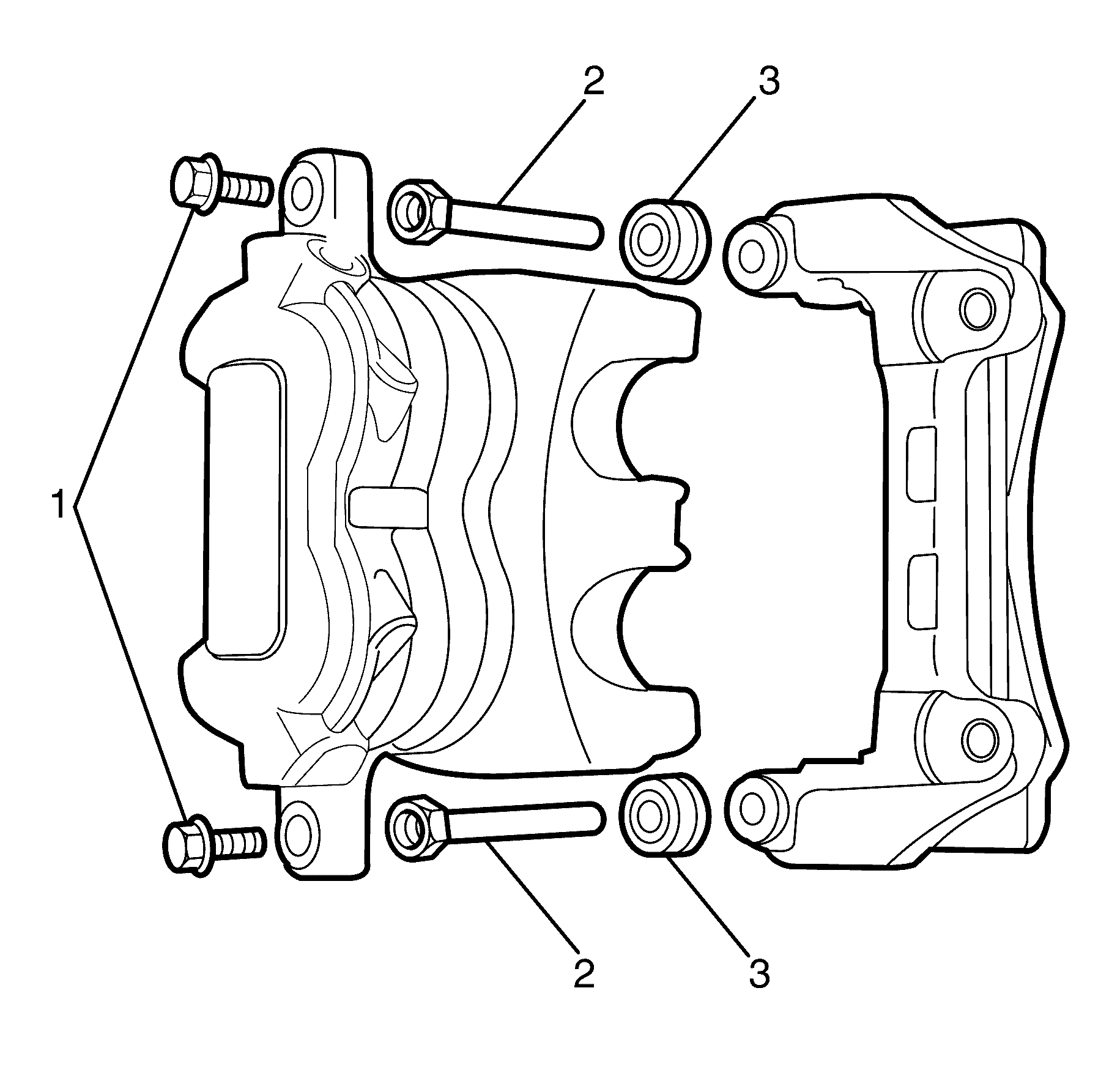
- Remove the brake caliper lower guide pin
retaining bolts (1).
- Inspect the brake caliper guide pins (2) for a smooth operation.
Gently pull the brake caliper guide pins (2) outward without disengaging the
guide from the brake caliper boots (3). Push the brake caliper guide pins (2)
inward, and inspect for the following:
| • | Bent or damaged brake caliper guide pin retaining bolts (1). |
| • | Bent or damaged brake caliper guide pins (2). |
- If any of the conditions listed are found, replace the brake caliper guide
pins (2).
- Inspect the brake caliper boots (3) for the following:
| • | Missing brake caliper boots (3). |
| • | Cracked or torn brake caliper boots (3). |
- If any of the conditions listed are found, replace the brake caliper boots (3).
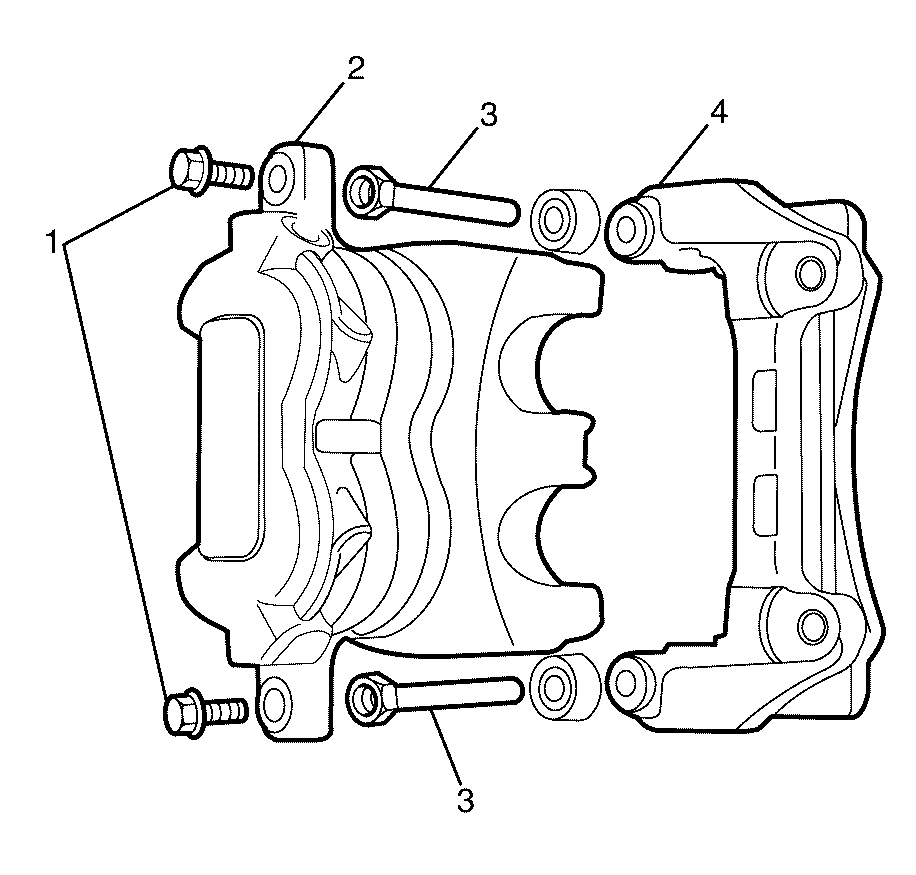
- Inspect the brake caliper (2) and
brake caliper anchor plate (4) for the following:
| • | Bent or damaged brake caliper anchor plate (4). |
| • | Excessive brake caliper guide pin (3) play in the brake caliper
anchor plate (4). |
| • | Excessive brake caliper guide bolt (1) play in the brake caliper (2). |
- If any of the conditions listed are found, replace the brake caliper (2).

- Inspect the brake caliper piston dust boot
seals (2) for cracks, tears, cuts, deterioration and/or incorrect seating in
the brake caliper (1). If any of these conditions are present, the brake caliper
requires overhaul or replacement.
- Inspect for brake fluid leakage around the brake caliper piston dust boot
seals (2) and on the brake pads. If there is any evidence of brake fluid leakage,
overhaul or replace the brake caliper (1).
Brake Caliper Inspection Rear
Caution: Refer to Brake Dust Caution in the Preface section.
Caution: Refer to Brake Fluid Irritant Caution in the Preface section.
- Inspect the fluid level in the master cylinder reservoir.
| • | If the brake fluid level is midway between the maximum-fill level and
the minimum allowable level, no brake fluid needs to be removed from the master cylinder
reservoir before proceeding. |
| | Important: DO NOT completely empty the master cylinder
reservoir or remove any brake lines otherwise complete bleeding of the braking system
will be necessary.
|
| | Important: DO NOT reuse the removed fluid.
|
| • | If the brake fluid level is higher than midway between the maximum-fill level
and the minimum allowable level, syphon the brake fluid to the midway point using
a hand vacuum pump before proceeding. |
- Remove wheels. Refer to
Tire and Wheel Removal and Installation
in Tires and Wheels.
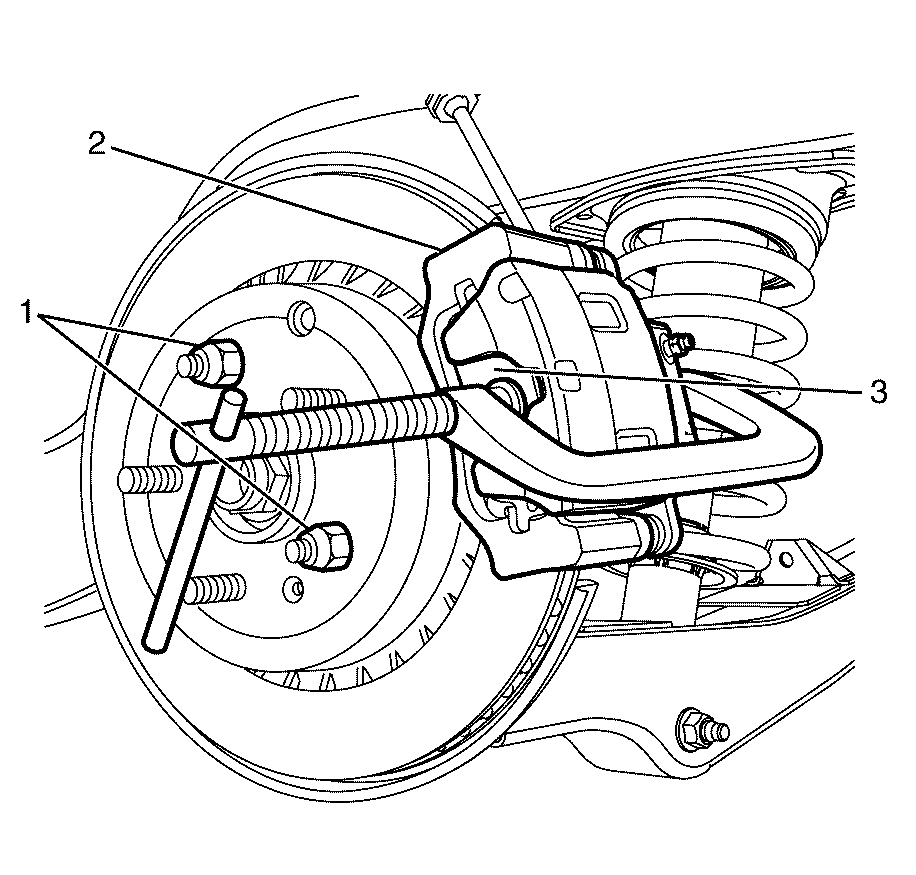
- Install two wheel nuts (1) in reverse
to opposite wheel studs to retain the brake disc to the hub.
Important: Position the ends of the G-clamp against
the rear of the brake caliper (2) and against the outboard brake pad (3).
- Install large G-clamp over the body of the brake caliper (2).
Important: The movement of a brake caliper piston into
a brake caliper bore should be smooth and even. If a brake caliper piston is frozen
or difficult to bottom out, the brake caliper requires overhaul or replacement.
- Inspect for smooth and complete travel of the brake caliper piston, into the
brake caliper bore.
Tighten the G-clamp until the brake caliper piston bottoms out in the brake
caliper bore.
- Remove the G-clamp from the brake caliper (2).
- Grasp the brake caliper (2) and try to move the brake caliper (2)
up or down.
The brake caliper (2) should have minimal freeplay.
- Grasp the brake caliper (2) and try to move the brake caliper (2)
in and out.
The brake caliper (2) should slide smoothly with minimal
force.
Important: DO NOT disconnect the hydraulic brake flexible
hose from the brake caliper.
- Remove the brake caliper. Refer to
Rear Brake Caliper Replacement
.
Notice: Support the brake caliper with heavy mechanic wire, or equivalent,
whenever it is separated from its mount and the hydraulic flexible brake hose is still connected. Failure to support the caliper in this manner will cause the flexible brake hose to bear the weight of the caliper, which may cause damage to the brake hose and
in turn may cause a brake fluid leak.
- Inspect the brake caliper to knuckle retaining bolts for the following:
| • | Bent or damaged brake caliper to knuckle retaining bolts. |
| • | Seizing in the knuckle. |
- If any of the conditions listed are found, replace the brake caliper to
knuckle retaining bolts.
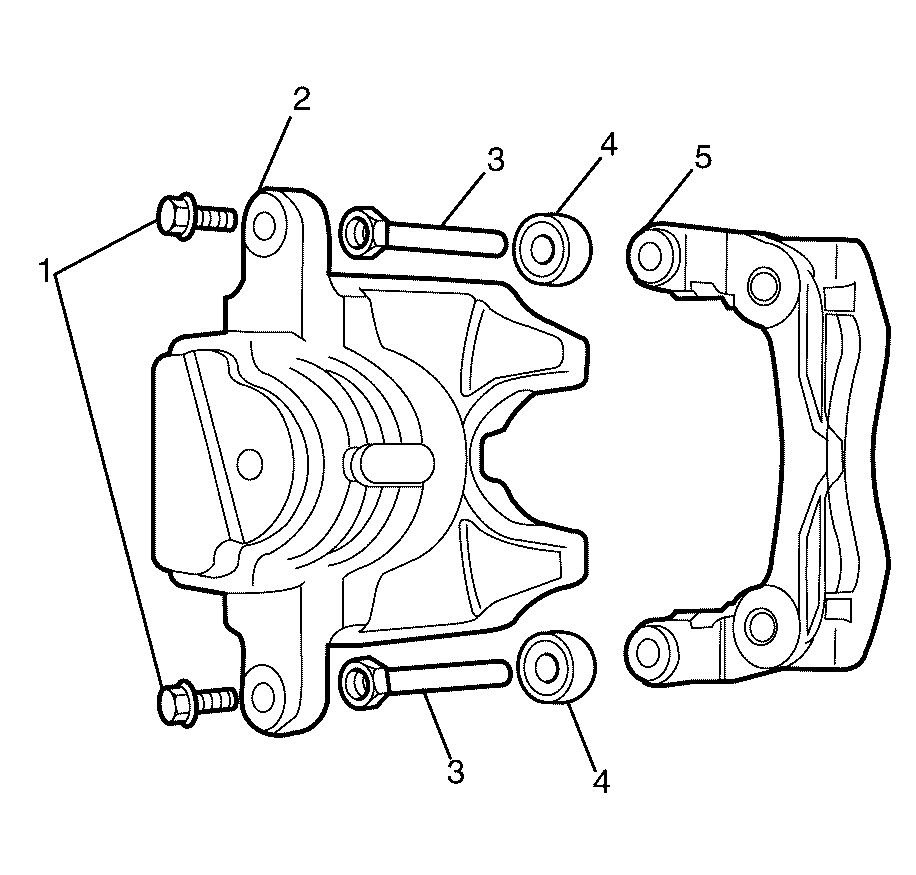
- Remove the brake caliper lower slide pin
retaining bolts (1).
- Inspect the brake caliper slide pins (3) gently pull the brake
caliper slide pins (3) outward without disengaging the slide pins from the
brake caliper boots (4). Push the brake caliper slide pins (3) inward,
and inspect for the following:
| • | Bent or damaged brake caliper slide pin retaining bolts (1). |
| • | Bent or damaged brake caliper slide pins (3). |
- If any of the conditions listed are found, replace the brake caliper slide
pins (3).
- Inspect the brake caliper boots (4) for the following:
| • | Missing brake caliper boots (4). |
| • | Cracked or torn brake caliper boots (4). |
- If any of the conditions listed are found, replace the brake caliper boots (4).
- Inspect the brake caliper (2) and brake caliper anchor plate (5)
for the following:
| • | Bent or damaged brake caliper anchor plate (5). |
| • | Excessive brake caliper slide pins (3) play in the brake caliper
anchor plate (5). |
| • | Excessive brake caliper slide bolts (1) play in the
brake caliper (2). |
- If any of the conditions listed are found, replace the brake caliper (2).

- Inspect the brake caliper piston dust boot
seals (2) for cracks, tears, cuts, deterioration and/or incorrect seating in
the brake caliper (1). If any of these conditions are present, the brake caliper
requires overhaul or replacement.
- Inspect for brake fluid leakage around the brake caliper piston dust boot
seals (2) and on the brake pads. If there is any evidence of brake fluid leakage,
overhaul or replace the brake caliper (1).







